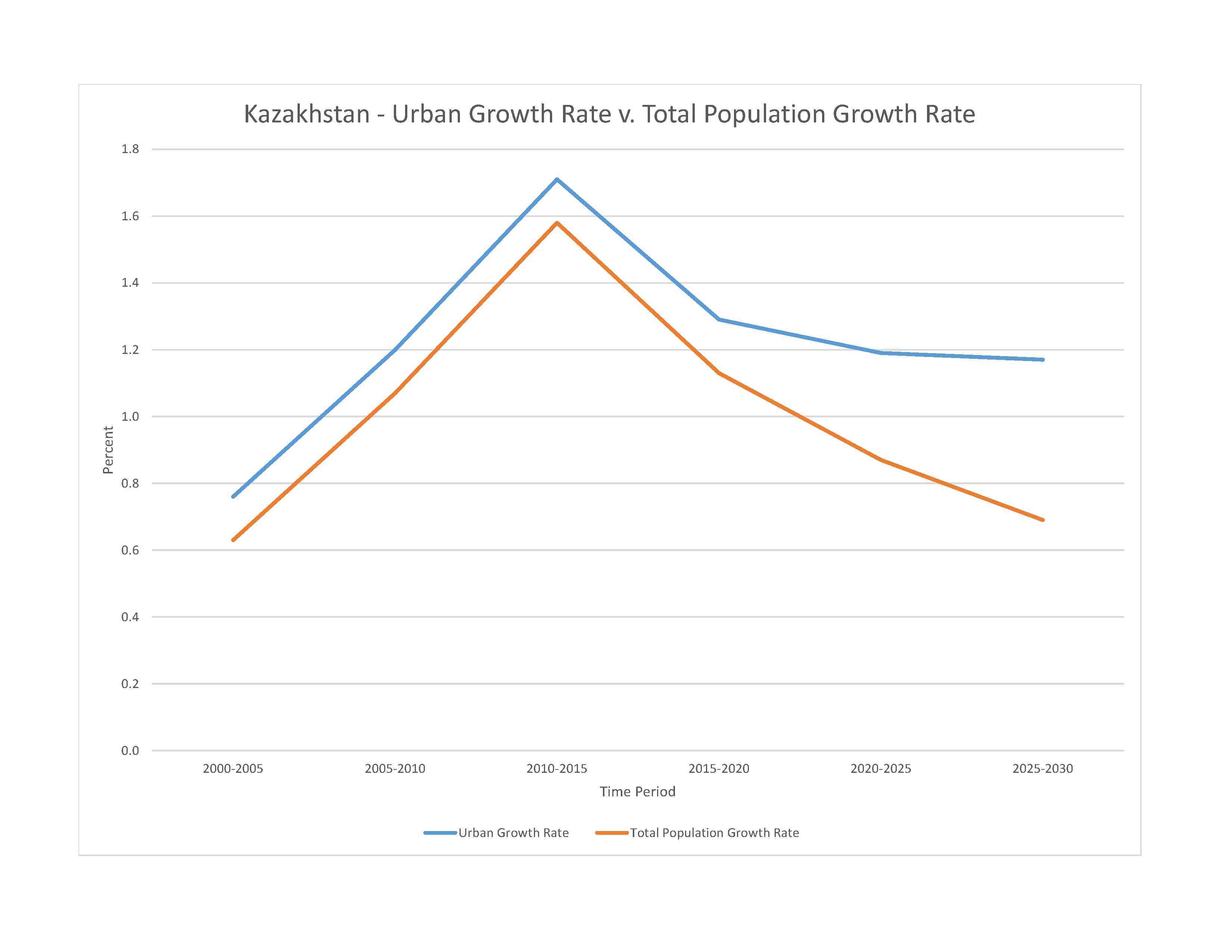
19,543,464 (2023 est.)
noun: Kazakhstani(s)
adjective: Kazakhstani
Kazakh (Qazaq) 69.6%, Russian 17.9%, Uzbek 3.3%, Uyghur 1.5%, Ukrainian 1.3%, Tatar 1%, other 5.3% (2022 est.)
Kazakh (official, Qazaq) 83.1% (understand spoken language) and trilingual (Kazakh, Russian, English) 22.3% (2017 est.); Russian (official, used in everyday business, designated the "language of interethnic communication") 94.4% (understand spoken language) (2009 est.)
major-language sample(s):
Әлемдік деректер кітабы, негізгі ақпараттың таптырмайтын көзі. (Kazakh)
Книга фактов о мире – незаменимый источник базовой информации. (Russian)
The World Factbook, the indispensable source for basic information.
Kazakh audio sample:
Russian audio sample:
Muslim 70.2%, Christian 26.2% (mainly Russian Orthodox), other 0.2%, atheist 2.8%, unspecified 0.5% (2009 est.)
Nearly 40% of Kazakhstan’s population is under the age of 25. Like many former Soviet states, Kazakhstan’s total fertility rate (TFR) – the average number of births per woman – decreased after independence amidst economic problems and fell below replacement level, 2.1. However, in the late 2000s, as the economy improved and incomes rose, Kazakhstan experienced a small baby boom and TFR reached 2.5. TFR has since fallen and is now just over 2.1. Mortality rates are also decreasing and life expectancy is rising, signs that Kazakhstan’s demographic transition is progressing.
Kazakhstan has a diverse population consisting of Asian ethnic groups (predominantly Kazakhs, as well as Uzbeks, Uighurs, and Tatars) and ethnic Europeans (mainly Russians but also Ukrainians and Germans). Approximately two thirds of Kazakhstan’s population today is Kazakh. During the mid-20th century, as Kazakhstan industrialized, waves of ethnic Russians and deportees from other parts of the Soviet Union arrived. Eventually, the ethnic Russian population outnumbered the Kazakhs. In the 1990s, following Kazakhstan’s independence, Russian and other ethnic Europeans began emigrating, while some ethnic Kazakhs (referred to as Oralmans) returned to their homeland from neighboring countries, China, and Mongolia. As a result, the country’s ethnic make-up changed, and a Kazakh majority was reestablished.
In recent years, Kazakhstan has shifted from being mainly a migrant-sending country to a migrant-receiving country. Due to its oil-driven economic boom, Kazakhstan has become a more popular destination. The country needs highly skilled workers in the industrial, business, and education sectors and low-skilled labor in agriculture, markets, services, and construction. Kazakhstan is increasingly reliant on migrant workers, primarily from Kyrgyzstan, Tajikistan, and Uzbekistan, to fill its labor shortage. At the same time, highly skilled Kazakhs continue to emigrate, mostly to Russia, seeking higher salaries or further education.
0-14 years: 25.26% (male 2386022/female 2,551,575)
15-64 years: 65.29% (male 6,226,792/female 6,533,887)
65 years and over: 9.44% (2023 est.) (male 660,397/female 1,184,791)
total dependency ratio: 60
youth dependency ratio: 47.2
elderly dependency ratio: 12.7
potential support ratio: 7.9 (2021 est.)
total: 31.7 years (2023 est.)
male: 29.9 years
female: 33.5 years
0.9% (2023 est.)
17.6 births/1,000 population (2023 est.)
8.2 deaths/1,000 population (2023 est.)
-0.4 migrant(s)/1,000 population (2023 est.)
most of the country displays a low population density, particularly the interior; population clusters appear in urban agglomerations in the far northern and southern portions of the country
urban population: 58.2% of total population (2023)
rate of urbanization: 1.19% annual rate of change (2020-25 est.)

1.987 million Almaty, 1.291 million NUR-SULTAN (capital), 1.155 million Shimkent (2023)
at birth: 1.07 male(s)/female
0-14 years: 0.94 male(s)/female
15-64 years: 0.95 male(s)/female
65 years and over: 0.56 male(s)/female
total population: 0.94 male(s)/female (2023 est.)
28.9 years (2019 est.)
13 deaths/100,000 live births (2020 est.)
total: 8.1 deaths/1,000 live births (2023 est.)
male: 9.1 deaths/1,000 live births
female: 7.1 deaths/1,000 live births
total population: 73 years (2023 est.)
male: 68.7 years
female: 77.7 years
2.59 children born/woman (2023 est.)
1.25 (2023 est.)
53% (2018)
note: percent of women aged 18-49
improved: urban: 100% of population
rural: 93.8% of population
total: 97.4% of population
unimproved: urban: 0% of population
rural: 6.2% of population
total: 2.6% of population (2020 est.)
3.8% of GDP (2020)
3.98 physicians/1,000 population (2020)
6.1 beds/1,000 population (2014)
improved: urban: 99.9% of population
rural: 99.9% of population
total: 99.9% of population
unimproved: urban: 0.1% of population
rural: 0.1% of population
total: 0.1% of population (2020 est.)
21% (2016)
total: 3.73 liters of pure alcohol (2019 est.)
beer: 2.52 liters of pure alcohol (2019 est.)
wine: 0.16 liters of pure alcohol (2019 est.)
spirits: 1.05 liters of pure alcohol (2019 est.)
other alcohols: 0 liters of pure alcohol (2019 est.)
total: 23.2% (2020 est.)
male: 39.6% (2020 est.)
female: 6.7% (2020 est.)
2% (2015)
61.8% (2023 est.)
4.5% of GDP (2020 est.)
definition: age 15 and over can read and write
total population: 99.8%
male: 99.8%
female: 99.7% (2018)
total: 16 years
male: 15 years
female: 16 years (2020)
NOTE: The information regarding Kazakhstan on this page is re-published from the 2024 World Fact Book of the United States Central Intelligence Agency and other sources. No claims are made regarding the accuracy of Kazakhstan 2024 information contained here. All suggestions for corrections of any errors about Kazakhstan 2024 should be addressed to the CIA or the source cited on each page.
This page was last modified 04 May 24, Copyright © 2024 ITA all rights reserved.